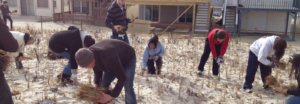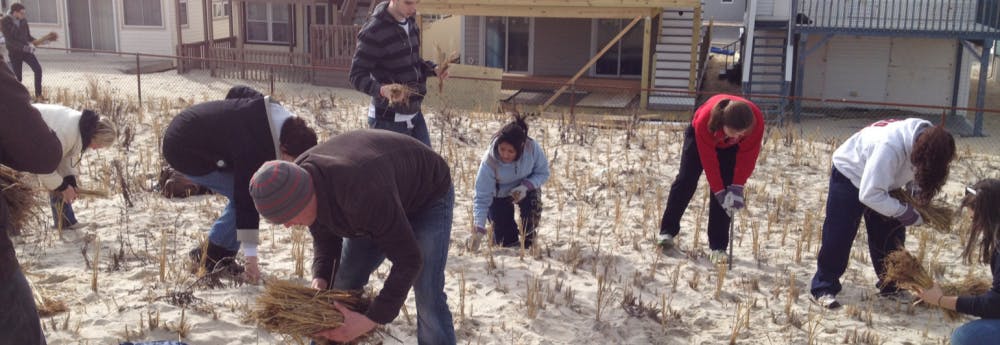By Breeda Bennett-Jones
Staff Writer
This past summer, catastrophic winds and heavy rainfall shook communities around the country.
In 2005, the College community was there for displaced Tulane University students affected by Hurricane Katrina. In 2010, the College was there for the survivors of the Haiti earthquake with Here For Haiti. In 2012, the College was there for students, families and those impacted by Hurricane Sandy with Here For Home. In 2017, the College is ready to aid communities damaged by natural disasters, once more, with its campaign Here For Home, Always.
Each year, the United States, in particular the Gulf Coast, braces itself for three harrowing months of strong hurricane potential.
This past summer, three Category 5 storms battered areas including Texas, Florida and Puerto Rico, leaving thousands without a home, food and water.
As communities across the country began to mobilize support for the victims of Hurricanes Harvey, Irma and Maria, the College regenerated its own initiative with Here For Home, Always.
The Division of Student Affairs, Student Government and the Center for Community Engaged Learning and Research, banded together to devise a plan.
As Houston flooded, the Steering Committee gathered in the office of Angela Chong, the vice president of Student Affairs. While Floridians evacuated, they laid out possibilities. As Puerto Rico went dark, they scribbled plans on a whiteboard hanging on the wall, according to Chong.

“We knew that we wanted to do something timely and sustainable,” Chong said. “At this very early stage, the best way that we could help was by raising money.”
The sustained initiative involves a four-step system, beginning with fundraising that started on Sept. 27.
Volunteers set up tables outside of the Brower Student Center hoping to attract students, while tables outside of the 1855 Room were intended to wheel in faculty and staff.
According to Chong, future steps include food and supply drives, potential outreach trips and exploring housing for displaced students.
The College’s dining services also contributed to the efforts with a similar event for fundraising initiatives in Eickhoff Hall and the 1855 Room. Dining services hoped to encourage students to donate to those affected by the hurricanes.
Chris Blakeley, executive president of SG and a junior civil engineering major, said SG has been involved in all the conversation surrounding Here For Home, Always.
As well as designing flyers, a logo and providing student feedback, Blakeley sits on the Steering Committee.
“We wanted to make sure whatever direction we went we would be able to help as many people as possible,” Blakeley said.
The College has continued its efforts with finding charities to donate to. Michael Nordquist, executive director for the Center of Community Engaged Learning and Research, focused on charities that coincided with the College’s beliefs.
“We wanted something that exemplifies TCNJ’s character and values,” Nordquist said.
The steering committee chose to donate its proceeds to the St. Bernard Project and United For Puerto Rico.
According to Chong, the St. Bernard Project is a non-profit natural disaster relief organization focused on long-term relief.
The St. Bernard Project has a long history with the College, as Bonner Scholars have worked directly with the non-profit organization in providing relief for those affected by Hurricane Katrina.
Bonner Scholars have continued to work directly with representatives in New Orleans for the past several years.
The St. Bernard project works extensively in different areas of the continental United States, but does not extend support to Puerto Rico.
United For Puerto Rico, Chong said, was a good choice for dispersing funds raised by students, faculty, alumni and parents.
The website says the organization, established by the Puerto Rico’s first lady Beatriz Rosello, gathers donations from civilians and private sectors, including Microsoft, Coca-Cola and JetBlue.
In 2012, the College lent a hand to the victims of Hurricane Sandy. According to Chong, faculty and staff headed to the Jersey Shore to help restore its beaches.
“There’s such a connection between our students and the New Jersey shore,” Chong said. “You’re either from there, or you vacation there at some point.”
The College remains active in its hurricane relief efforts. Every January, first-year Bonner Scholars drive to New Orleans to work on rebuilding efforts with the St. Bernard Project.
Alumna Brittany Aydelotte (‘09), a research and initiatives program manager at the Center For Engaged Learning, has stayed in contact with many of the homeowners that she has helped.
A small orange folder in her office contains Christmas cards and pictures of families with emails, phone numbers and addresses jotted on the back. Group photos of smiling Bonner Scholars clad in sneakers, college sweatshirts and safety vests are clipped to her bookshelf.
Fifteen trips, 380 students, 11,400 hours and 31 homes later, Aydelotte said the experience is still just as transformative.
Aydelotte described her experience rebuilding homes in New Orleans as grounding, inspiring and gratifying.
“If you’re eating in a restaurant and you’re covered in drywall, everyone will thank you. These are people, not just houses,” she said.
Despite being hundreds of miles from the affected areas, Chong emphasized that students can, and should, help.
“We’re still here for home. Home just looks a little bit different,” Chong said.







